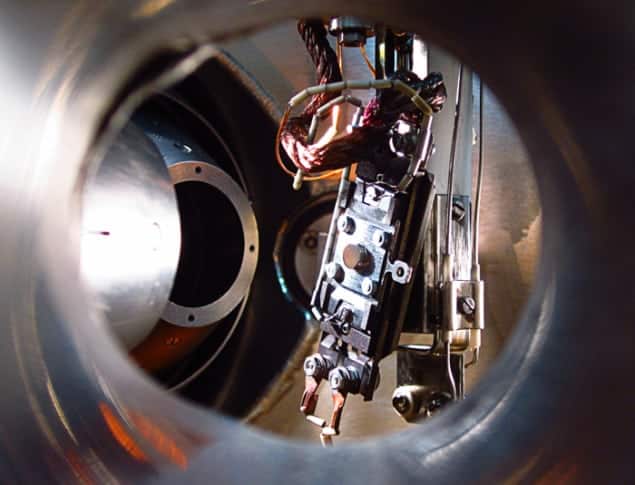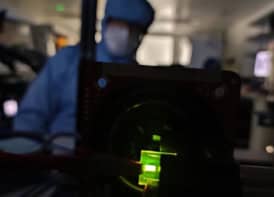
An experimental technique called “electron coincidence spectroscopy”, which provides important information about the electronic properties of surfaces, could be coming to a lab near you thanks to work done by physicists in Germany. Wolf Widdra and colleagues at Martin Luther University and the Max Planck Institute of Microstructure Physics in Halle have developed a version of the technique that does not require light from a large-scale synchrotron facility, but rather can be done on a bench top.
The technique involves detecting pairs of electrons that are emitted simultaneously when a photon or an electron is absorbed by a material. It could therefore be useful for studying superconductors and other materials with correlated electrons, which interact so strongly with each other that it is impossible to predict their properties simply by studying the behaviour of individual electrons alone.
Creating and detecting pairs
The researchers’ main challenge in developing their instrument was finding a way to create and then detect enough pairs of electrons to make a meaningful measurement reasonably fast. Simply blasting a sample with a continuous beam of radiation is no good because unrelated electrons can then be mistaken for simultaneously emitted pairs. What Widdra’s team did instead was to deliver the electrons or photons to the surface in short pulses before looking at electrons that are emitted shortly after each pulse is absorbed.
While this can be done in the lab using incident electrons, more useful photon-based experiments are restricted to large synchrotron facilities. Unfortunately, such labs only operate in the required pulsed mode for one or two weeks a year. As a result, doing electron coincidence spectroscopy at a synchrotron involves a lot of effort in setting up and dismantling an experiment for a very limited experimental run.
While the required ultraviolet pulses can be produced on a bench top, the rate had been limited to about a kilohertz, which is not fast enough to complete a measurement in a reasonable amount of time. Widdra’s bench-top system is able to deliver pulses of ultraviolet photons at a rate of 1 MHz by firing intense pulses from an infrared laser at a noble gas such as argon.
The intense electric field from the pulse can cause an electron to be pulled away from an atom before falling back into its orbital. This involves the emission of a “higher-harmonic” photon that is a multiple of the frequency of the photons in the original laser pulse. The team’s set-up produces short pulses of photons with energies in the range 13–45 eV, which are then sent through a monochromator to create a beam at a single photon energy of 30 eV.
To Halle and back
When a pair of electrons is produced, the two particles fly off in different directions and can be captured by two commercial time-of-flight (TOF) electron spectrometers that are arranged at 90° to each other. Each spectrometer has an acceptance angle of 30°, which means that pairs with a wide range of trajectories can be studied. The momentum of each electron is determined from the time it takes to travel from the sample to a position-sensitive detector at the opposite end of the TOF spectrometer – with the stopwatch starting with the arrival of the incident photon or electron pulse.
After calibrating their instrument using ultraviolet pulses at the BESSY II synchrotron, the researchers brought it back to the lab in Halle, where they used their new laser set-up to study the surface of a nickel oxide (NiO) sample. NiO is an ideal sample to test the efficacy of the spectrometer because its electrons are expected to have strong correlations. The team measured the momenta of electron pairs emitted by a NiO surface when illuminated by ultraviolet pulses, then did a similar measurement on a copper sample, which should not harbour strongly-correlated electrons. The study revealed that the energy distribution of the electron pairs from NiO was very different from pairs emitted by copper.
“Our observation is that metals and NiO behave very differently. This implies that our technique allows us to quantify the electron correlation strength,” says Michael Huth of the Max Planck Institute.
Superconductor studies
The team is now using its spectrometer to study other materials as well as making measurements over a range of different photon energies to gain a better understanding of electron correlations. The team expects that the instrument could be used to study the role of electron correlations in a number of different physical phenomena including superconductivity, metal-insulator transitions and long-range magnetic ordering.
Widdra adds that the team is also looking to commercialize its ultraviolet source because it would prove very useful for a wide range of surface-science experiments in addition to electron coincidence spectroscopy.
The instrument is described in Applied Physics Letters.


